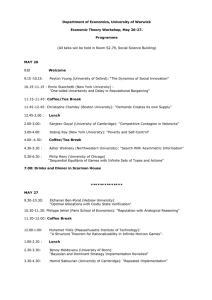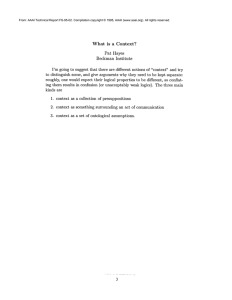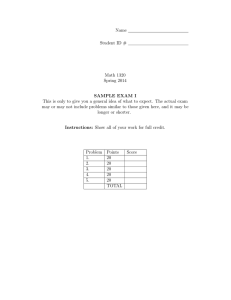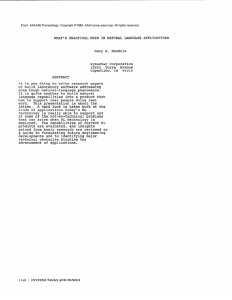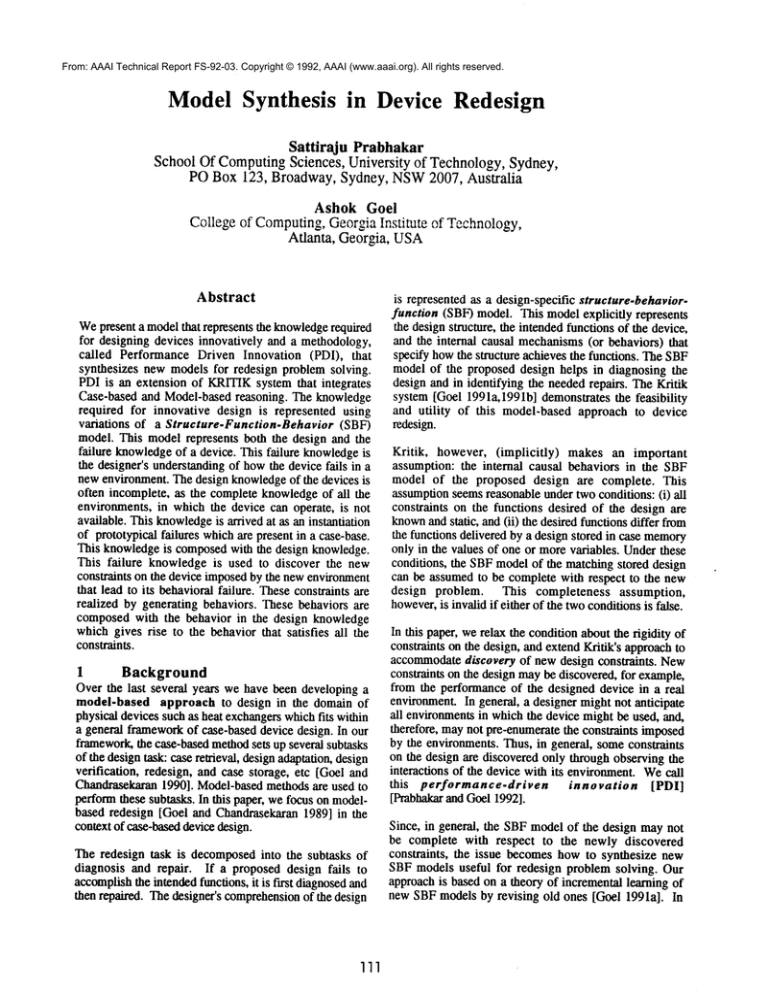
From: AAAI Technical Report FS-92-03. Copyright © 1992, AAAI (www.aaai.org). All rights reserved.
Model Synthesis
in Device Redesign
Sattiraju
Prabhakar
School Of Computing Sciences, University of Technology, Sydney,
PO Box 123, Broadway, Sydney, NSW2007, Australia
Ashok Goei
College of Computing, Georgia Institute
of Technology,
Atlanta, Georgia, USA
Abstract
Wepresent a modelthat represents the knowledgerequired
for designing devices innovatively and a methodology,
called Performance Driven Innovation (PDI), that
synthesizes new models for redesign problem solving.
PDI is an extension of KRITIKsystem that integrates
Case-based and Model-based reasoning. The knowledge
required for innovative design is represented using
variations of a Structure-Function.Behavior
(SBF)
model. This model represents both the design and the
failure knowledgeof a device. This failure knowledgeis
the designer’s understanding of howthe device fails in a
new environment. The design knowledgeof the devices is
often incomplete, as the complete knowledgeof all the
environments, in which the device can operate, is not
available. This knowledgeis arrived at as an instantiation
of prototypical failures whichare present in a case-base.
This knowledgeis composedwith the design knowledge.
This failure knowledge is used to discover the new
constraints on the device imposedby the new environment
that lead to its behavioral failure. Theseconstraints are
realized by generating behaviors. These behaviors are
composed with the behavior in the design knowledge
which gives rise to the behavior that satisfies all the
constraints.
1
Background
Over the last several years we have been developing a
model-based approach to design in the domain of
physical devices such as heat exchangerswhichfits within
a general frameworkof case-based device design. In our
framework,the case-based methodsets up several subtasks
of the design task: case retrieval, design adaptation, design
verification, redesign, and case storage, etc [Goel and
Chandrasekaran 1990]. Model-based methods are used to
perform these subtasks. In this paper, we focus on modelbased redesign [Goel and Chandrasekaran 1989] in the
context of case-based device design.
The redesign task is decomposedinto the subtasks of
diagnosis and repair. If a proposed design fails to
accomplishthe intended functions, it is fast diagnosedand
then repaired. The designer’s comprehensionof the design
111
is represented as a design-specific structure-behavior.
function (SBF) model. This model explicitly represents
the design structure, the intended functions of the device,
and the internal causal mechanisms(or behaviors) that
specify howthe structure achieves the functions. The SBF
model of the proposed design helps in diagnosing the
design and in identifying the needed repairs. The Kritik
system [Goel 1991a,1991b] demonstrates the feasibility
and utility of this model-based approach to device
redesign.
Kritik, however, (implicitly)
makes an important
assumption: the internal causal behaviors in the SBF
model of the proposed design are complete. This
assumption seems reasonable under two conditions: (i) all
constraints on the functions desired of the design are
knownand static, and (ii) the desired functions differ from
the functions delivered by a design stored in case memory
only in the values of one or more vaxiables. Underthese
conditions, the SBFmodel of the matching stored design
can be assumed to be complete with respect to the new
design problem. This completeness assumption,
however,is invalid if either of the twoconditions is false.
In this paper, we relax the condition about the rigidity of
constraints on the design, and extend Kritik’s approach to
accommodatediscovery of new design constraints. New
constraints on the design maybe discovered, for example,
from the performance of the designed device in a real
environment. In general, a designer might not anticipate
all environmentsin which the device might be used, and,
therefore, maynot pre-ennmerate the constraints imposed
by the environments. Thus, in general, some constraints
on the design are discovered only through observing the
interactions of the device with its environment. Wecall
this performance-driven
innovation
[PDI]
[Prabhakar and Goel 1992].
Since, in general, the SBFmodel of the design may not
be complete with respect to the newly discovered
constraints, the issue becomes how to synthesize new
SBF models useful for redesign problem solving. Our
approach is based on a theory of incremental learning of
new SBFmodels by revising old ones [Goel 1991a]. In
From: AAAI Technical Report FS-92-03. Copyright © 1992, AAAI (www.aaai.org). All rights reserved.
addition to past designs and their SBFmodels, we posit
that designer’s often mayknowof prototypical design
failures
and the causes for them. This idea of
prototypical failures and their causes is borrowedfrom our
earlier work on taxonomic organization of causal
knowledge for diagnosis [Prabhakar, et al 1990].
Knowledge
of prototypicai failures and their causes can be
expressed as a causal model for the failure. Given a
specific type of failure of a design, the causal modelfor
the correspondingprototypical failure can be instantiated
and composed with the incomplete SBF model of the
design to obtain a new and more complete SBF model
useful for redesign.
2
An Illustrative
Example
Weillustrate our aproach to model synthesis in device
redesign, through an example of household automatic
coffee makers. Let us suppose that a designer takes as
input a set of constraints that specify the functionality
desired of the coffee maker, namely, automatic brewingof
coffee-decoction from coffee powder and hot water. The
design that realizes this function is shownin Figure 1.
This design has two containers,
with container-1
positioned above the container-2. The design also has a
filter in between these two containers. The filter is
positioned such that it makes contact with the bottom
surface of the container-l. Initially, container-I contains
coffee powder. As hot water is added to it, the coffee
powderdissolves in the water, forming a mixture of coffee
powder, water and coffee decoction as indicated in Figure
I A. Coffee decoction permeates through the filter and
gets collected in container-2 as illustrated in Figure-lB.
Note that this design for the coffee makersatisfies all the
initial constraints on the given design problem.
Nowsuppose that the design is instantiated in a prototype
coffee makerand it is used in a real setting, it is found
that while the coffee makerfails to deliver required output
behaviors in someoperating environments. Specifically,
the coffee-makerdelivers luke-warmcoffee-decoction in a
cold environment.
CONTAE’~ER.I
HOT
FIGURE.IA
COFFEE.
DECOCTION
FIGURE-In
FIGURE1: A Design for the Coffee Maker
The designer mayreason about this output behavior by
first forming a causal explanation for it. He might infer
112
that the reason why the coffee decoction reaches the
bottom container only lukewarmis that the coffee making
process is taking a long time and during this time heat
escapes from the coffee decoction in the top container to
the environment. This causal explanation may lead the
designer to the formulation of new constraints on the
design problem. Specifically, the time taken to brew the
coffee needs to be reduced significantly. Given the new
design constraints, and the causal explanations for
undesirable output behaviors, the designer might create a
new design. He might, for example, introduce a plunger
into the top container to speed up the process of coffee
brewing. This, he might reason, wouldreduce the time the
coffee decoction remainsin the top container. In fact, this
is precisely the design of manymoderncoffee makers.
Note also that the "’causal explanations" here are of a very
specific kind: they relate the structure of the coffee maker
to its output behaviors, where the output behaviors are a
superset of the functions of the device. That is, the causal
explanations specify the processes and mechanisms by
which the structure produces its output behaviors. The
SBF models capture precisely these internal causal
behaviorsof the device.
3
SBF Models of Physical
Devices
The SBF model of a device explicitly represents its
structure, intended functions, and internal causal
behaviors.
Kritik’s
SBF models are based on a
component.substance
ontology
of
CONSOLIDATION
[Bylander and Chandrasekaran 1985].
The SBFmodel of a device is specified in behavioral
representation language that builds on Functional
Representation
Scheme (FR Scheme)
[Sembugamoorthyand Chandrasekaran 1986].
The structure of a device in Kritik as constituted of
components(e.g., battery, pipe, container), substances
(e.g., water, electrical charge, coffee-powder)and relations
between them (e.g., connection, containment). The
substances can be abstract, e.g., heat. The components
and substances can have behavioral interactions. For
example, substances can be allowed to flow from one
component to another if there is a certain type of
structural relation betweenthe two components,viz., the
connection relation. A substance can also have behavioral
interactions with other substances. This is represented as a
substance has a property with-respect-to
another
substance. For example, coffee-powder can dissolve in
water. This is represented as water has solubility-capacity
of mediummagnitude with-respect-to coffee-powder. The
typology of primitive behavioral interactions is borrowed
from the consolidation. For example, a battery pumps
electrical charge and a pipe allows substances with
certain properties. Knowledge
of the structure of the device
is organized in a structure-substructure
hierarchy. A
substructure is represented as a schemathat specifies its
functional abstractions, its modalities, parameters and
From: AAAI Technical Report FS-92-03. Copyright © 1992, AAAI (www.aaai.org). All rights reserved.
their operating ranges, its substructures and behavioral
state transitions.
GIVEN
QUAlcrrrY
~E=DRJM
.....
FIGURE
2. The Function of the Coffee Maker
A function of a deviceis viewedas a transformationfrom
one behavioralstate to another. Knowledge
of a function
is further represented in the form of a schema. The
function schemaspecifies the behavioralstate it takes as
input and the behavioral state it gives as output. For
example, the function, MakeCoffeeFunction,shownin
Figure2, has twostates. Thegivenstate of this function
specifies that the coffee powderand water are in
containerl. The makesstate specifies that the coffee
decoctionis in container2. Afunction also specifies the
internal causal behaviorthat results in the function, and
the stimulus from the environment which triggers
behaviors. For example, the MakeCoffeeFunction
specifies
the internal
causal behavior,
MakeCoffeeBehavior.
Theschemefor using functions as
indices to causal behaviorsis borrowedthe FRscheme.
Aninternal causal behavior of a device is viewedas a
sequenceof behavioralstate transitions. Knowledge
of a
behavior is represented as a directed acyclic graph of
behavioral states and state transitions. Theinternal
behavior of coffee makercalled MakeCoffeeBehavior,
is
shownin Figure 3.
A state in a behavior is represented in the form of a
schema. The state schema specifies the location,
property, and parameters and parameter values of a
substance. For example,in statel of Figure 3, (some
quantity of) Wateris at the location, containerl in the
device space and has the properties of temperatureand
solubility with values T1 and S respectively. Thestate
schemamayalso specify the substancescontainedwithin
a substance.
Atransition in a behavioris annotatedby the primitive
behavioralinteractions that cause the state transition to
occur, e.g., the transition fromone state to another is
causedby a primitive function. Atransition mayalso be
annotated by the enabling conditions under which the
behavioral interactions result in the transition. The
enablingconditionsin one behaviormaypoint to another
behavior. Finally, a transition maybe annotated by
domainprinciples underlying the transition, and the
parametric relations between the state variables
characterizing the precedingand succeedingstates. For
example, Figure 3 shows a state, representing the
containerl with water, coffee-powder
andcoffee-decoction,
makesa transition to another state, representing the
container2with coffee-decoction.This state transition has
three annotations. I. The first annotation specifies a
contact relation betweenbottom surface of containerl
and the filter. This is a restriction on the flow of
substances between componentswhich says that if a
substance flows through one componentin contact with
another, then it has to go flowthroughthe other onealso
if it allows the substance. 2. The function allow of
bottom-surface
of containerlspecifies that it allowsthe
MakeCoffeeRehlvior
,.~U~’qTI’I’Y MEDIUM
CONT/~,~
Ni
WKI’Ell
]Dissoluuon/~ws of Solids [
li~ I"iq uicts
|
QUAIVTT[’YSMALL
W^rE~
~
SOL-
.MEDIUM
/
QU~’qI"rI’Y
SMALL
COFFEE- QUA/,CrITY"
MEDIUM
DECOCT/ON
hN.THE-CONTEXT-OF.
STRUCTURAJ~RELATION
I
CONTACT
{C(~---~
CONTA/NER-2COFFE~- QUANTITY MEDIUM
DECOCTION
FIGURE
3. The Internal Causal Behaviorof Coffee Maker
ll3
From: AAAI Technical Report FS-92-03. Copyright © 1992, AAAI (www.aaai.org). All rights reserved.
coffee-decoction to flow from containerl to container2
through the bottom-surface of containerl. 3. Filterl also
has a function a//ow whichspecifies that the filter allows
the coffee-decoctionto flow from containerl to container2.
SBF model of the device, and composition of the
instantied process modelwith the old SBFmodel.
i CONTAINER-I
4
COPI’~/:DECOCTION TEMPERATURE
HIGH
Causal Models of Prototypical
Failures
HEAT
OUANTITY
LARGE
I
fi
i ADDITION-OF-DOMAJaN-PRINCIPI~
!"
~~anucs
E.VVIRONMENT
¯
I
CONT.M~NER-2
~ HEAT
’’[-’AlLURE-PATH ~1
I’"E
DECOC’TR~N T’~’MPERATUI~
/
I
FA.[L URE-PATH-CONDITION
CONTAINER-WALL’S
HEAT
ALLOWCAPACITYHIGH
!
HEAT QUANTITY S ,~,IALL
Figure 4: A Causal Modelof the Prototypical Failure due
to Heat Loss
Figure 4 illustrates the causal modelfor the prototypical
failure of cooling of substances due to heat loss to the
environment. This process model is based on the same
component-substance ontology and described in the same
behavioral representation language as the SBFmodel of
specific devices. As illustrated in Figure 4, the cooling of
substances due to heat loss to the environmentis modeled
in terms of generic components(containerl, container2
and pipe) and generic substances (dev-sub and env-sub).
The modelspecifies that heat flows from dev-sub to envsub via the pipe even as the dev-sub flows from
containerl to container2. The modelpoints to the Zeroth
Law of Thermodynamics as the physics principle
governing the heat flow. (This law states that whentwo
substances or components with different temperatures
come in contact, heat from the substance/component at
the higher temperature flows to the substance/component
at the lower temperature.) In addition, the modelspecifies
the two conditions under which the heat flow mayoccur:
(i) the failure-path-condition pertains to the deviceenvironment interaction and specifies that the walls of
container-I and container allow the flow with a large
capacity; and (ii) the failure-condition pertains to the
internal behaviorof the device itself and specifies that the
rate of flow of dev-sub is small.
5
LOW
r
Composing Design and Failure
Models
The new SBFmodel that can explain the performance of a
device is synthesized from the old SBF model of the
device that explains howthe device achieves its intended
functions and process models of prototypical device
failures stored in memory.The synthesis of the new SBF
model involves two steps: instantiation of the process
modelof the prototypical failure in the context of the old
]]4
Figure 5: An Instantiation
Loss
of the Causal Model of Heat
Figure 5 illustrates the instantiation of the causal model
for substance cooling in the context of the SBFmodelof
coffee maker. The instantiated causal model is composed
with the SBF model of the coffee maker by failure
state links. The behavioral states in design and failure
behaviorsare linked by failure state extension links.
6
Constraint Discovery
The point in synthesizing the new SBFmodel is that it
helps to formulate new design constraints.
Once
formulated, the redesign process can attempt to
accommodate the new constraints.
The coffee maker
illustrated in Figure 1 is constrained with old constraints.
The goal is to create a design that is satisfies the old and
newconstraints.
Figure 6 shows a process model for discovery of new
constraints and (re)design of a completely constrained
design. The key idea is that newconstraints are to violate
the failure-condition
and failure-path.condition
in
the causal model of prototypical failure shownin Figure
4. This is because the old design failed due to these
conditions, and, therefore, if these conditions can be
negated, then the causes for the design failure can be
corrected. The violation or negation of these conditions
generates new functional constraints on the design.
In the coffee makerexample,for instance, the violation of
the failure-condition
of Figure 4 leads to the
formulation of a new function illustrated in Figure 7. The
failure-condition, shown as an initial state in Figure
7, specifies that the coffee-decoctionis at the location in
between container-1 and container-2 and its flow-rate is
small. The violation of this condition generates the final
state of Figure 7, which specifies that the flow-rate of
From: AAAI Technical Report FS-92-03. Copyright © 1992, AAAI (www.aaai.org). All rights reserved.
coffee-decoction be large. This forms a new functional
constraintfor the designto satisfy.
7
Case Composition
CONTAINER-1
DECOCTION TEMPERATURE
~
HIGH
QUANTrTY
l
LA.RGE[
USINC-~FUNCTION
Com~Demc~n
oecom=~-i
(o~-,---l,
conmmer-2)
i CONTA L’~,’ER-2Fr~
DECOCTION~~RATL1REQUANTITy~HIGH~]
COFI-F.I~.
FIGURE8. The PUMPfunction of Plunger Retrieved
from Memory
MakeCofft~Wit hPhm~r Bel~vim" (s~.~.m~.2)
HEAT
QUANTITY
LARGE
FIGURE
6. A Process Modelof Constraint Discovery and
Redesign
"I’~MPF/RATUR~ HIGH
,~~’rrY
LARGE
HEAT
ALLOW
of~l
~
(~-I
,
~ STRUCTUIO,
I,- RI~..AT/ON
C(~TACT{Cmmmm.I
i USII~FUNc’rION
ALLOWS-=
:~
,
ol’~l
(~m~wr-
USINO-FUNCTION
l~Yl"~ Cm"~"n""" ~" I
film’l)
HF.AT
[]
DECOCTIOW
lllOmtA11/Itll~
CONTAinS-2
QUA~FITrY LARGE
CO~~ 0UANTffY
D~COC’nO~
~
~’rul~
,
ttlGI-I
FIGURE
9. NewDesign for Coffee Makerwith Plunger
As indicated in Figure 6, once the new functional
constraints are gnerated, the old design is redesignedby
retrieving additional design cases from memoryand
composingthem with the old design. To return to the
coffee makerexample, the new functional constraint
shownin the bottomhalf of Figure 7 acts as a probeinto
the case memory. The case memory is organized
functionally as in Kritik [Goel 1991b]. That is, the
FIGURE
7. Formulation of NewConstraint
115
From: AAAI Technical Report FS-92-03. Copyright © 1992, AAAI (www.aaai.org). All rights reserved.
designs cases are indexed by the functions they deliver,
where the design functions are specified in the language
illustrated in Figure2.
the International Federation for Information Processing
WG5.2 Conference on Intelligent
Computer-Aided
Design, Columbus, Ohio, 1991, pp. 269-292.
Let us suppose (for the sake of completingthis argument)
that the case memorycontains a design for Plunger whose
functional specification is shownin Figure 8. Whenthe
new functional constraint is sent to probe the case
memory,the redesigner retrieves the design for the plunger
and adds it to die design of the coffee maker. The new
design for the coffee maker is shownin Figure 9. Note
that although we have not discussed the failure-pathcondition in Figure 4 in detail,
it too can be
accommodatedin a similar manner.
[Goel and Chandrasekaran 1989] A. Goel and B.
Chandrasekaran. "Functional Representation of Design and
Redesign ProblemSolving". Proc. Eleventh International
Joint Conference on Artificial Intelligence, Detroit,
Michigan, pp. 1388-1394, 1989.
8
Related
Research
Our work differs from earlier work on redesign, e.g.
[Marcus, Stout and McDermott 1988], in three major
ways: our work discovers new constraints, uses causal
models of device-independent prototypical failures, and
reuses past designs in designing and redesigning newones.
Our work on model-based design has much in common
with other research work such as [Williams 1991]. Both
Williams and we use teleological and causal models of
physical devices and processes. Wediffer, in the sense that
the device designs and models, in our method, are created
by retrieving, adapting and composingpast designs and
models stored in memoryfor reuse. PDI assumes that
constraints are dynamic,not static. Our workin case-based
reasoning
is similar
to work by Navinchandra
[Navinchandra 1991]. We differ in the sense while
Navinchandra’s approach focuses on exploring the case
memory,our approach emphasizes the grounding of casebased method in a deeper understanding of domain
principles and processes. Finally, our workis related to
recent research on innovative and creative design. The PDI
introduces new variables into the design knowledge.This
is defined as creative design [Gero1990].
REFERENCES
[Bylander and Chandrasekaran 1985] T. Bylander and B.
Chandrasekaran.
"Understanding
Behavior Using
Consolidation".Proc. Ninth International Joint Conference
on Artificial Intelligence, pp. 450-454,1985.
[Gero 1990] J. Gero. "Design Prototypes: A Knowledge
Representation Schemafor Design". AI
Magazine,
11(4): 26-36, Winer 1990.
[Goel 1991a] A. Goel. Model Revision: A Theory of
Incremental Model Learning. In Proceedings of the
Eighth International Conference on Machine Learning,
Chicago, June 27-29, 1991, pp. 605-609, Los Altos, CA:
Morgan Kaufmann.
[Goel 1991b] A. Goel. Representation
of Design
Functions in Experience-Based Design. In Proceedings of
116
[Goel and Chandrasekaran 1990] A. Goel and B.
Chandrasekamn.A Task Structure for Case-Based Design.
InProceedings
of the 1990 IEEE International
Conference on Systems, Man, and Cybernetics, Los
Angeles, California, November4-7 1990, pp. 587-592.
[Goel and Prabhakar 1991] A. Goel and S. Prabhakar. "A
Control Architecture for Model-based Redesign Problem
Solving". Artificial Intelligence in Design Workshop,
Proc. TwelfihlnternationalJoint
Conference
on
Artificial Intelligence, pp.121-136, Sydney, Australia,
Aug. 1991.
[Marcus, Stout and McDermott 1988] S. Marcus, J.
Stout, and J. McDermott. "VT: An Expert Elevator
Designer that Uses Knowledge-BasedBacktracking". AI
Magazine, 9(1):95-114, 1988.
[Navinchandra 1991] D. Navinchandra. ExplOration and
Innovation in Design. NewYork: Springer-Verlag, 1991.
[Prabhakar and Goel 1992] S. Prabhakar and A. Goel.
Using diagnostic experiences in experience-based
innovative design. In Proceedings of Applications of
Artificial Intelligence X: Knowledge-BasedSystems, pp.
420-434, 1992.
[Prabhakar, Murthy and Patnaik 1990] S. Prabhakar,
I.S.N. Murthy and L.M. Patnaik. "Diagnosing Multiple
Faults using a Taxonomic Organization of Deep Level
Causal Knowledge". AAAI Spring Symposium Series: AI
in Medicine, Stanford University, 1990.
[Sembogamoorthy and Chandrasekaran
1986] V.
Sembugamoorthy and B. Chandrasekaran. "Functional
Representation of Devices and Compilation of Diagnostic
Problem Solving Systems". In Experience. Memoryand
Reasoning, J. Kolodnerand C. Riesbeck (editors), pp. 4773. Hillsdale, NewJersey: Erlbaum, 1986.
[Williams 1991] B. Williams. "Interaction-based Design:
Constructing Novel Devices from First Principles". In
Proceedings of IFIP International CADConference,
Columbus, Ohio, 1991.

